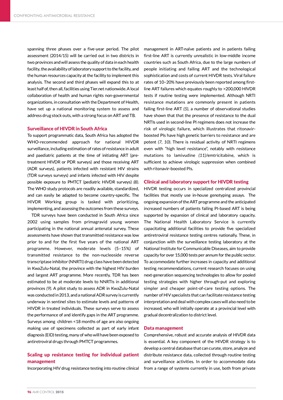
presence of resistance to the dual NRTIs used in second-line
PI regimens does not increase the risk of virologic failure,
which illustrates that ritonavir-boosted PIs have high
genetic barriers to resistance and are potent. There is
residual activity of NRTI regimens even with "high level
resistance", notably with resistance mutations to
lamivudine/emtricitabine, which is sufficient to achieve
virologic suppression when combined with ritonavirboosted
PIs. A small proportion of patients fail first-line
regimens in the absence of resistance; providing resistance
testing to accommodate these patients on a programmatic
level is not cost effective, nor will the result provide
information on archived mutations. At present, it is difficult
to justify routine HIV drug resistance testing for patients
experiencing first-line ART failure in resource limited
settings.
South Africa has recently implemented access to third-line
ART in the public sector. Access to third-line ART requires
demonstration of "low level" or higher resistance to PIs.
Empiric switches to third line ART following virologic failure
would be a waste of resources as most people currently
failing second line ART have no PI resistance and are failing
due to poor adherence. There are over 200 adult patients,
and 40 paediatric patients on this programme, initiated in
2013, and outcomes are currently being described. Selecting
people who are likely to benefit from HIV resistance testing
requires a thorough assessment of adherence and exposure
to PIs for a minimum of 12 months. Establishing evidencebased
recommendations for rationing access to resistance
testing is a priority.
Once PI resistance has been confirmed in patients failing
second line ART a new regimen is constructed based on
ritonavir-boosted darunavir together with the most
active dual NRTI combination (always including
lamivudine/emtricitabine), with the addition of raltegravir
and possibly also etravirine for patients with more extensive
resistance. The third line regimen is approved by a small
central committee of experts. An algorithm based
recommendation for selecting third line antiretrovirals is
being developed so that provincial experts can select
regimens.
Clinical and laboratory support to achieve goals
The scaling-up of resistance testing for clinical management,
as well as improving continuum of care and patient
outcomes, will require expansion of clinical and laboratory
capacity. A cadre of HIV specialists that can facilitate
resistance testing interpretation is required, that will
initially operate at a provincial level with gradual
decentralization to district level. Specialist provincial
centres for referral of complex cases will continue. The
National Health Laboratory Service is currently capacitating
additional facilities, to provide five specialized testing
centres nationally. These, in conjunction with the
surveillance testing laboratory at the National Institute for
Communicable Diseases, aim to provide capacity for up to
30,000 tests per annum for the public sector. To
accommodate increased capacity, current research focuses
on using next-generation sequencing technologies to allow
for pooled testing strategies, and exploring point-of-care
testing options.
Data management
Comprehensive, robust and accurate analysis of HIVDR data
is essential. A key component of the HIVDR strategy is to
develop a central database that can curate, store, analyze
and distribute resistance data, collected through routine
testing and surveillance activities. In order to accommodate
data from a range of systems currently in use, both from
private and public sectors, a minimum set of standardized
information has been devised, to be reported to the NDoH
national database at quarterly intervals. From this, the
HIVDR working group will produce written report and
electronic summaries to the NDoH.
New therapies
More than 20 antiretroviral drugs, including coformulations,
are approved in the United States and Europe.
Whilst efforts are required to preserve current regimens,
new ART options for high-burden countries must be
explored. New regimens must provide for easier adherence,
have higher resistance barriers, and be affordable. Of note,
the integrase inhibitor dolutegravir could be a viable option
to replace efavirenz in first-line regimen, due to superior
viral suppression, fewer side-effects, low dosage and low
cost. No resistance to integrase inhibitors has been
documented in patients exposed to standard first-line
CONFRONTING ANTIMICROBIAL RESISTANCE
96 AMR CONTROL 2015
A small proportion of patients fail firstline
regimens in the absence of
resistance; providing resistance testing
to accommodate these patients on a
programmatic level is not cost effective,
nor will the result provide information
on archived mutations